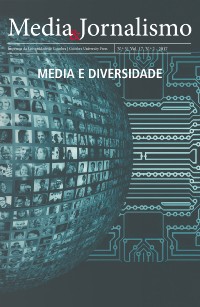Please use this identifier to cite or link to this item:
https://hdl.handle.net/10316.2/93469| DC Field | Value | Language |
|---|---|---|
| dc.contributor.author | Vecchio-Lima, Myrian Del | - |
| dc.contributor.author | Souza, Humberto da Cunha Alves de | - |
| dc.date.accessioned | 2017-11-16T17:21:57Z | |
| dc.date.accessioned | 2020-10-04T03:37:41Z | - |
| dc.date.available | 2017-11-16T17:21:57Z | |
| dc.date.available | 2020-10-04T03:37:41Z | - |
| dc.date.issued | 2017 | - |
| dc.identifier.issn | 1645‑5681 | - |
| dc.identifier.issn | 2183-5462 (digital) | - |
| dc.identifier.uri | https://hdl.handle.net/10316.2/43231 | - |
| dc.description.abstract | Apesar da feminização das redações jornalísticas latino-americanas, o Global Report on the Status of Women in the News Media (2015) aponta que o estatuto profissional superior nestes espaços é ainda masculino, o que ocasiona menos probabilidade de mulheres cobrirem histórias ou serem personagens de reportagens; o mesmo relatório indica que o percentual de mulheres como fonte de informação ainda é baixo. O processo reproduz uma visão patriarcal persistente e é parte da chamada “invisibilidade” da mulher na mídia. Este trabalho pressupõe que também no Brasil, o processo de feminização das redações não é acompanhado de conteúdo que valorize a mulher, embora haja avanços. O texto apresenta cinco experiências brasileiras de jornalismo digital que buscam preencher a lacuna da cobertura tradicional sobre questões femininas, tratando a mulher como sujeito social autônomo. Examinou-se a estrutura destas iniciativas e analisou-se o conteúdo de cinco matérias de cada produto, nos meses de julho/agosto de 2016, para verificar como a mulher aparece como protagonista social. O trabalho permitiu refletir sobre um “novo jornalismo” que supere estereótipos, induzindo à visibilização e ao empoderamento social das mulheres. Conclui-se que as iniciativas analisadas podem ser consideradas pontos de observação para integrar práticas positivas no jornalismo hegemônico, ampliando o uso democrático e igualitário da mídia. | por |
| dc.description.abstract | Despite the feminization of journalistic newsrooms in Latin America, the Global Report on the Status of Women in the News Media (2015) indicates that the top professional status in those places is still male, which leads to a lower likelihood of women writing stories, or being it’s characters; the same report also demonstrates Vtha the percentage of women as a source of information is still low. The process reproduces the persistent patriarchal vision and is part of the so-called women «invisibility» in the media. This work assumes that also in Brazil, the feminization process of the editorial staff does not come along with any content that values the woman, although there are advances. The text presents five digital journalism experiments that seek to fill the gap of traditional coverage on women’s issues, treating woman as an autonomous social actor. The structure of these initiatives was examined and their content, during the period July/August of 2016, have been analysed to verify how the woman appears as a social protagonist. This work allowed a reflection on how the «new journalism» can overcome stereotypes, inducing the visibility and the social empowerment of women. It is concluded that the analyzed initiatives can be considered points of observation to integrate positive practices in hegemonic journalism, expanding the democratic and egalitarian use of the media. | eng |
| dc.language.iso | por | - |
| dc.publisher | Imprensa da Universidade de Coimbra | - |
| dc.rights | open access | - |
| dc.subject | women invisibility | eng |
| dc.subject | journalism | eng |
| dc.subject | digital journalism | eng |
| dc.subject | gender stereotype | eng |
| dc.subject | no hegemonic media | eng |
| dc.subject | invisibilidade das mulheres | por |
| dc.subject | jornalismo | por |
| dc.subject | jornalismo online | por |
| dc.subject | estereótipo de gênero | por |
| dc.subject | mídias não hegemônicas | por |
| dc.title | Espaços alternativos na internet como formas de visibilizar as mulheres no jornalismo brasileiro | por |
| dc.title.alternative | Alternative spaces on the internet as a mean to make women visible in brazilian journalism | por |
| dc.type | article | - |
| uc.publication.collection | Media & Jornalismo nº 31, vol. 17, nº 2 | - |
| uc.publication.firstPage | 131 | - |
| uc.publication.issue | 31 | - |
| uc.publication.lastPage | 152 | - |
| uc.publication.location | Coimbra | - |
| uc.publication.journalTitle | Media & Jornalismo: uma revista do Centro de Investigação Media e Jornalismo | - |
| uc.publication.volume | 17 | por |
| dc.identifier.doi | 10.14195/2183-5462_31_9 | - |
| uc.publication.orderno | 9 | - |
| uc.publication.area | Artes e Humanidades | - |
| uc.publication.manifest | https://dl.uc.pt/json/iiif/10316.2/93469/264778/manifest?manifest=/json/iiif/10316.2/93469/264778/manifest | - |
| uc.publication.thumbnail | https://dl.uc.pt/retrieve/12090658 | - |
| item.grantfulltext | open | - |
| item.fulltext | With Fulltext | - |
| Appears in Collections: | Media & Jornalismo | |
Files in This Item:
| File | Description | Size | Format | |
|---|---|---|---|---|
| espacos_alternativos_na_internet_como_formas_de_visibilizar_as_mulheres_no_jornalismo_brasileiro.pdf | 2.51 MB | Adobe PDF |  |
Items in DSpace are protected by copyright, with all rights reserved, unless otherwise indicated.
